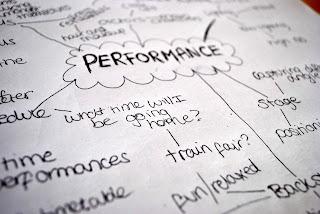A sketch helps generate ideas because they are usually just roughly done in pencil and can be either worked on in detail or left at just a rough sketch which has sparked another idea to create a new sketch. Sketches don't have to be artistically good or aesthetically pleasing, as long as you can understand them yourself and they help you generate ideas that's all that matters. Sketches are useful to record and preserve ideas as soon as they come to mind - this helps with remembering a strong idea as if you hadn't sketched it down and tried to remember it later on that day the idea might not be as strong in your mind.
Here are some examples of sketches :
Maquettes :
A Maquette is almost like a 3D sketch. It is an idea that is developed using 3D material. This can be clay, playdough, cardboard, paper, etc. It is usually a rough model of an idea which will help you develop the idea to become a final one. They are used to test ideas and shapes before actually having to fork out the costs of the final one to discover it's not going to work.
Here are some examples of Maquettes.
Mood boards :
A mood board is a form of idea generation mainly using imagery and words to generate a visual mass of ideas. A mood board might be created by searching for a particular subject online, printing out every picture it comes up with and sticking them down on a piece of paper/card next to each other and seeing what colour themes seem to stand out. This could then trigger ideas from the colour scheme. A mood board doesn't have to be created just by cutting out images and sticking them down, they can be made digitally using Photoshop or Microsoft Word. Mood boards that are hand made can be as creative or non-creative as the person who is making it likes. They can simply just stick pictures down or they can use textures and 3D effects to help build on their ideas.

Here is a digital mood board I created by searching for various different things on Google that are to do with performing arts. This mood board shows me that the majority of pictures that come up when searching for performing arts are taken in landscape format. I think that the pictures look better like this rather than portrait because you can get a wider angle and capture more that's going on in the play/performance. I also think that performance photography looks good in landscape format because the stage that people are performing on will generally be wide rather than narrow.
Mind-map :
Here is my spider-gram on performance. I used performance as the key word in the centre of the mind map (the spider's body) and branched out to lots of different things that I would have to consider/could possibly give me ideas on what to shoot for my final core project.
Exquisite corpses :
Exquisite corpse (also known as exquisite cavader) means rotating corpse. This method of idea generation is where a group of contributors generate ideas by collectively assembling images or words. The first person might draw a head on a piece of paper, then fold it down so the next person cannot see what they have drawn. The next person will then draw an idea of their own to represent the body, and fold it down and pass it onto the next person. When all contributors have added their own idea, the piece of paper is opened to reveal the final product. This may look vert strange but it may trigger ideas. Exquisite corpses also work for story telling. The first person might write a beginning of a story, fold it down and pass it to the person, and the process is repeated until everyone has written something. The paper will then be unfolded to reveal the story which may be very strange but might trigger some ideas.
Word association :
Word association is a word game where you start with one word and think of other words that associate with it to generate ideas. My first word was performance and I asked other people in my class to think of a word that associated with it, then a word that associated with the one that the first person had come up with. Word associations are good for generating ideas because you might come up with an idea that you wouldn't originally think of when trying to base ideas on a theme. A brilliant idea may come up when you've thought of 50 words to do with your original topic.












No comments:
Post a Comment